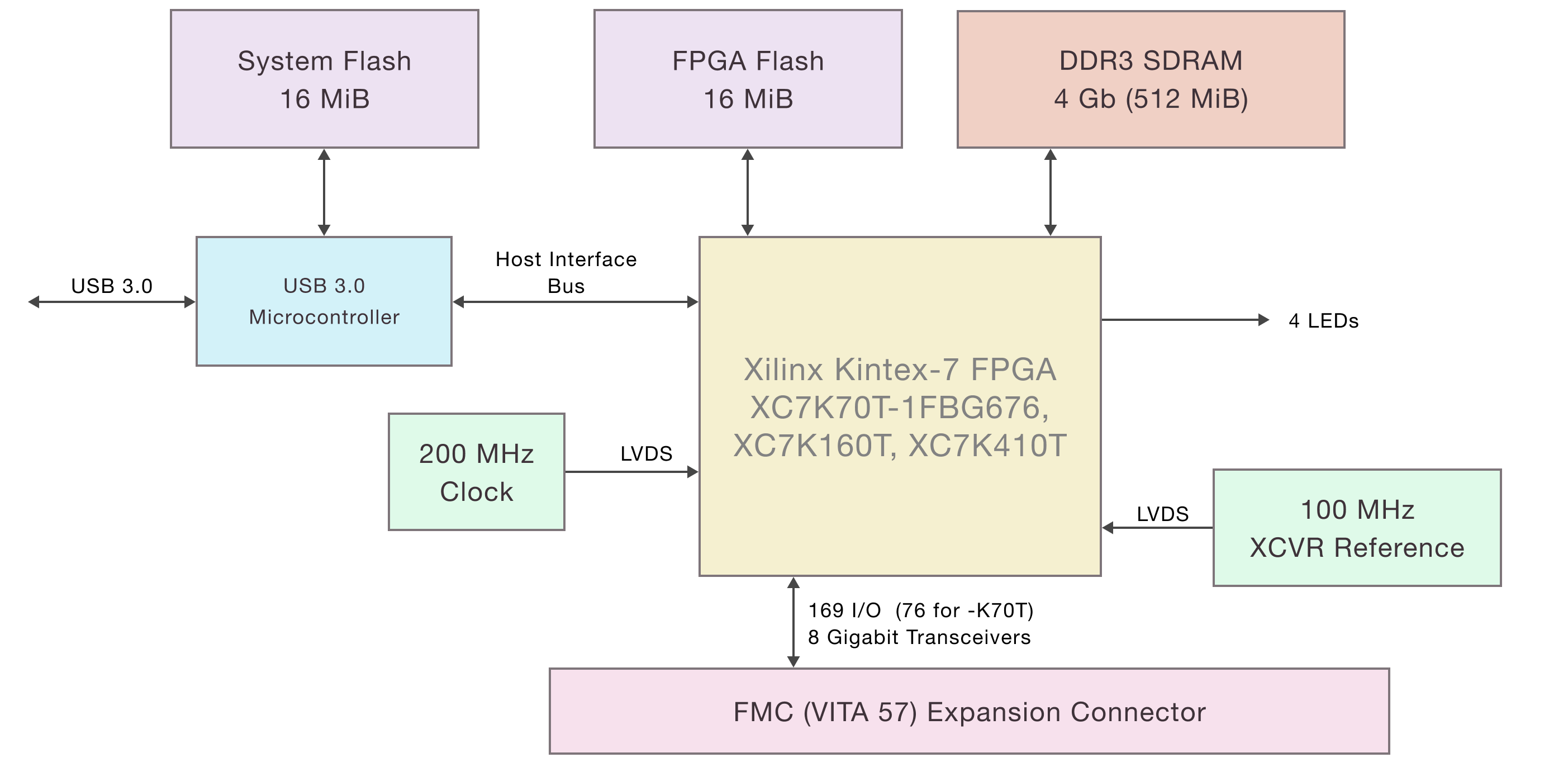Introduction

The XEM7350 is a compact FPGA board featuring the AMD Kintex-7 FPGA and SuperSpeed USB 3.0 connectivity via a USB 3.0 Micro-B receptacle.
Designed as a full-featured integration and evaluation system, the XEM7350 provides access to over 169 I/O pins on its 676-pin Kintex-7 device and has a 512-MiByte DDR3 SDRAM available to the FPGA. Two SPI Flash devices provide a total of 32 MiB of non-volatile memory, one attached to the USB microcontroller and one attached to the FPGA.
Available with K70T, K160T, and K410T FPGA densities, the XEM7350 is designed for high-performance system integrations with transceiver-capable FMC modules including JESD204B data converters.
Documentation and Reference Materials
The following is a comprehensive list of documentation available for this device.
| XEM7350 User’s Manual | This online documentation space. |
| XEM7350 Pins Reference | The interactive Pins reference for the device provides detailed pinout information as well as automated constraint file generation. Export functionality is provided to PDF, CSV. Constraint files are provided for UCF, XCD (AMD) and QSF, SDF (Altera). |
| FrontPanel SDK User’s Manual | The online documentation space for the FrontPanel SDK. |
| FrontPanel API Reference | Online API reference with detailed usage for every API method. |
Functional Block Diagram

FPGA
The XEM7350 is offered in three variants. These variants are identical except for the FPGA provided. The table below lists some of the differences between the two devices. Please consult the AMD documentation for a more thorough comparison.
| FEATURE | XEM7350-K70T | XEM7350-K160T | XEM7350-K410T |
|---|---|---|---|
| FPGA | XC7K70T-1FBG | XC7K160T-1FFG | XC7K410T-1FFG |
| Slice Count | 10,250 | 25,350 | 63,550 |
| D Flip-Flops | 82,000 | 202,800 | 508,400 |
| Distributed RAM | 838 Kib | 2,188 Kib | 5,663 Kib |
| Block RAM | 4,860 Kib | 11,700 Kib | 28,620 Kib |
| DSP Slices | 240 | 600 | 1,540 |
| Clock Management Tiles | 6 | 8 | 10 |
SuperSpeed USB 3.0 Interface
The XEM7350 uses a Cypress FX3 USB microcontroller to make the XEM a USB 3.0 peripheral. As a USB peripheral, the XEM is instantly recognized as a plug and play peripheral on millions of PCs. More importantly, FPGA downloads to the XEM happen quickly, virtual instruments under FrontPanel update quickly, and data transfers are blazingly fast.
On-board Peripherals
The XEM7350 is designed to compactly support a large number of applications with a small number of on-board peripherals. These peripherals are listed below.
Low-Jitter Crystal Oscillators
A fixed-frequency, 200 MHz, low-jitter oscillator is included on-board and outputs LVDS to the FPGA. The Kintex-7 FPGA can produce a wide range of clock frequencies using the on-chip DCM and PLL capabilities.
A second 100 MHz oscillator is available to the transceiver portions of the FPGA as a reference.
512-MByte Word-Wide DDR3 Synchronous DRAM
The XEM also includes a 512-MiByte DDR3 SDRAM with a full 16-bit word-wide interface to the FPGA. This SDRAM is attached exclusively to the FPGA and does not share any pins with the expansion connector. The maximum clock rate of the SDRAM is 800 MHz. With the -1 speed grade of the Kintex-7, the maximum clock rate is 800 MHz (400 MHz for the -K70T) for a supported peak memory bandwidth of 25.6 Gb/s (12.8 Gb/s for the -K70T).
The DDR3 SDRAM is a Micron MT41K256M16HA-125:E (or compatible).
FPGA Flash – 16 MiB Serial Flash Memory
A 128 Mib serial flash device (Numonyx N25Q128A11B1240E or equivalent) provides on-board non-volatile storage for the FPGA. This device is attached directly to the FPGA for use in your design.
System Flash – 16 MiB Serial Flash Memory
A 128 Mib serial flash device (Numonyx N25Q128A11B1240E or equivalent) provides on-board non-volatile storage accessible to the USB microcontroller. This device is used to store device firmware and configuration settings as well as other user assets such as FPGA configuration files or calibration data. Erase, read, and write functions are available at all times (with or without a configured FPGA) through the use of FrontPanel API methods.
LEDs
Four LEDs and are available for general use as indicators.
FPGA Fan Controller
A small connector provides power to an optional 5v fan mounted on the FPGA heat sink. This power is under the control of the microcontroller.
Device Sensors
On-board voltage and current sensors provide real-time access to several power supply measurements through the FrontPanel SDK sensors API.
FrontPanel Support
The XEM7350 is fully supported by Opal Kelly’s FrontPanel Application. FrontPanel augments the limited peripheral support with a host of PC-based virtual instruments such as LEDs, hex displays, pushbuttons, toggle buttons, and so on. Essentially, this makes your PC a reconfigurable I/O board and adds tremendous value to the XEM7350 as an experimentation or prototyping system.
Programmer’s Interface
In addition to complete support within FrontPanel, the XEM7350 is also fully supported by the FrontPanel SDK, a powerful C++ class library available to Windows, Mac OS X, and Linux programmers allowing you to easily interface your own software to the XEM.
In addition to the C++ library, wrappers have been written for C#, Java, and Python making the API available under those languages as well. Sample wrappers (unsupported) are also provided for Matlab and LabVIEW.
Complete documentation and several sample programs are installed with FrontPanel.
Copyright
Software, documentation, samples, and related materials are Copyright © 2006-2021 Opal Kelly Incorporated.
Opal Kelly Incorporated
Portland, OR
https://www.opalkelly.com
All rights reserved. Unauthorized duplication, in whole or part, of this document by any means except for brief excerpts in published reviews is prohibited without the express written permission of Opal Kelly Incorporated.
Opal Kelly® and FrontPanel® are registered trademarks of Opal Kelly Incorporated. Linux is a registered trademark of Linus Torvalds. Microsoft and Windows are both registered trademarks of Microsoft Corporation. All other trademarks referenced herein are the property of their respective owners and no trademark rights are claimed.